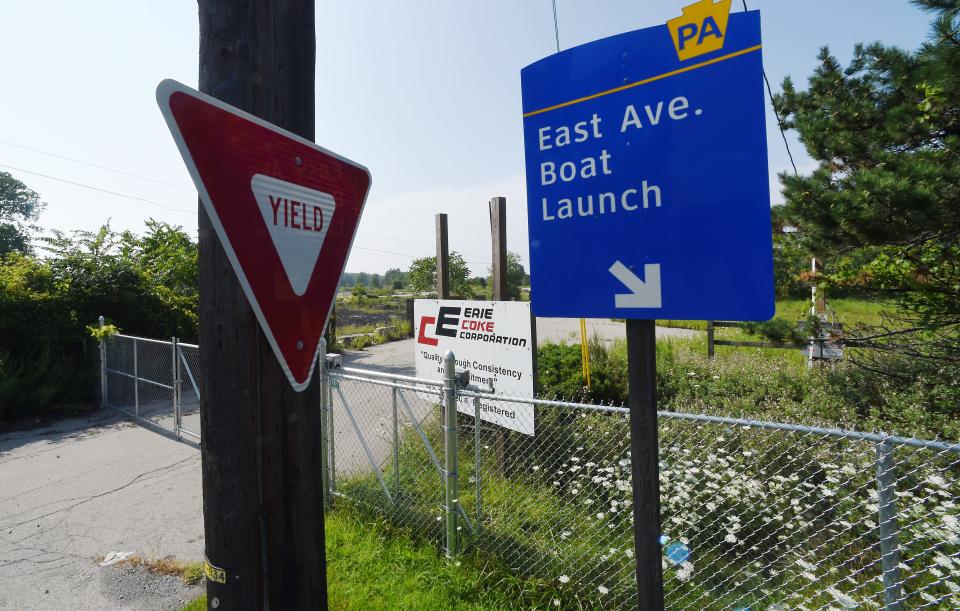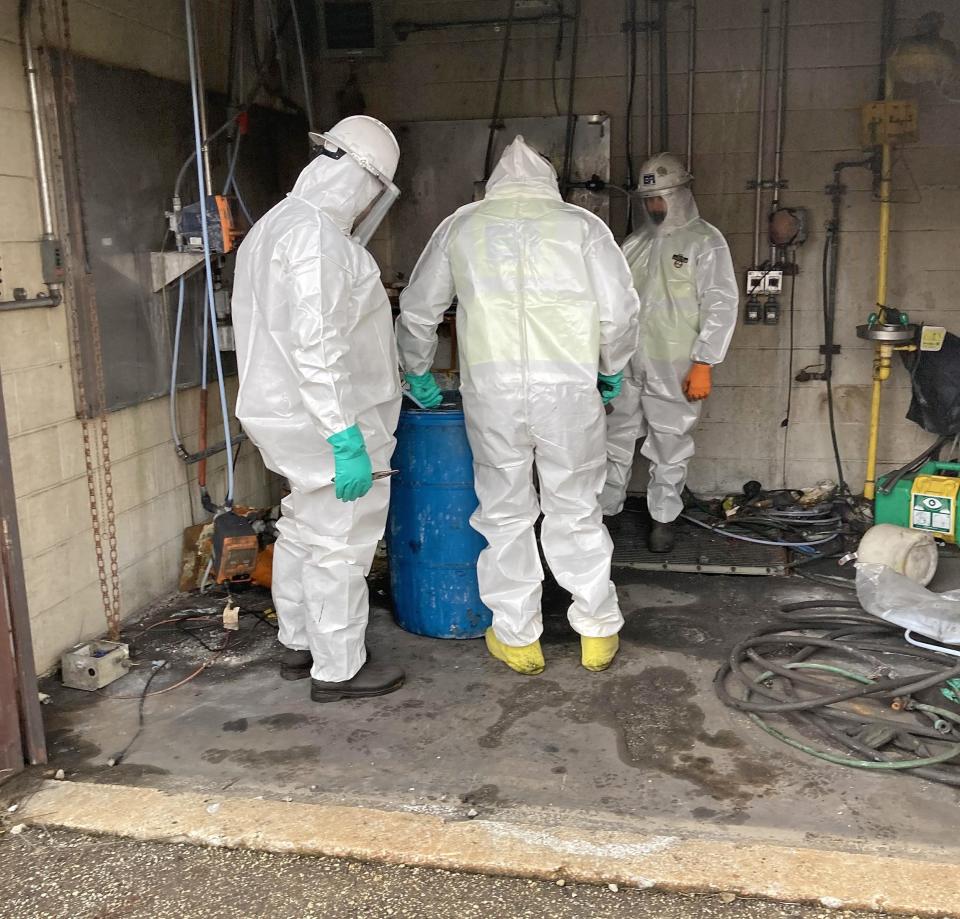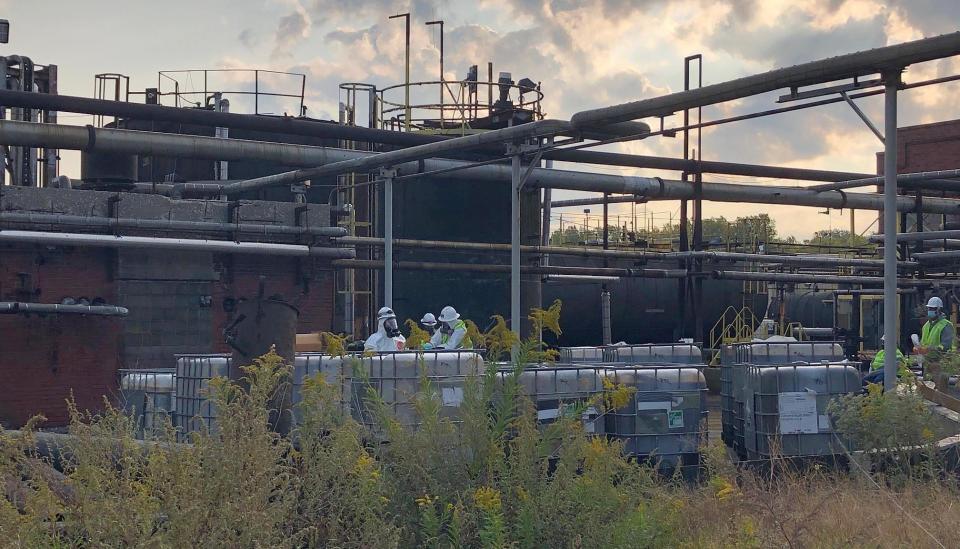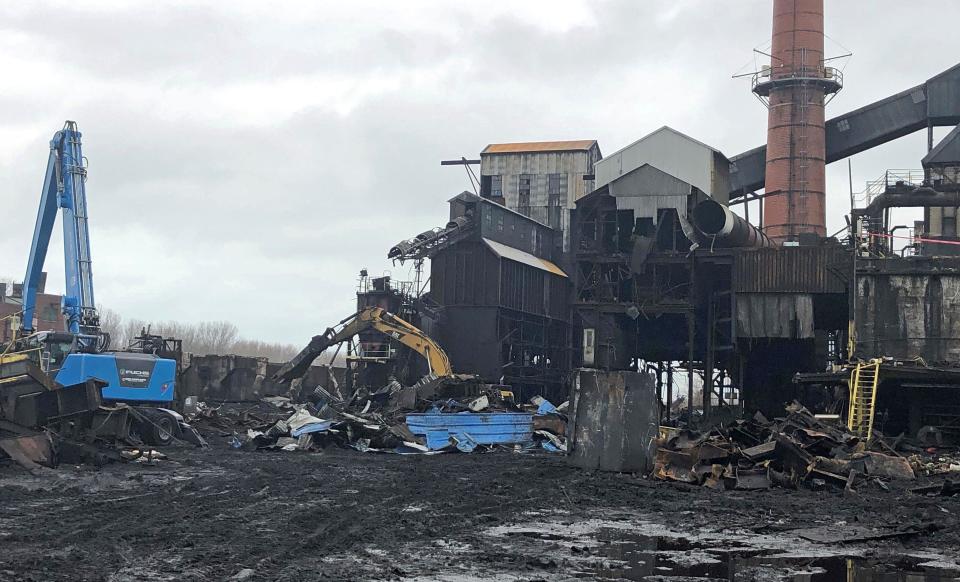Erie Coke site seen as 'potential threat to human health and the environment'
A long-awaited report on contaminants at the former Erie Coke plant concludes that the property poses a potential environmental threat to the feature that makes the property most valuable — Lake Erie.
Pollutants from the shuttered factory, whose footprint includes 2,000 feet of shoreline along the lake at the foot of East Avenue, have contaminated shoreline sediments, and pollutants also were discharged into the lake improperly for years, according to the report, prepared for the state Department of Environmental Protection.
The contaminants got into the lake because "waters from site operations were insufficiently processed prior to discharge into Lake Erie," according to the report, issued July 31.
It states that the lakeshore sediments got contaminated largely due to the dumping of polluted materials over the bluff that overlooks Lake Erie. "The impact to shoreline sediments is likely a function of contaminant leaching from the decades of disposing of various process waste on and over the bluff above the shoreline," according to the report.

Runoff from the site has "adversely affected the water quality of Lake Erie," according to the report. It concludes: "In general, the site can be considered a potential threat to human health and the environment."
The report recommends more environmental testing on the site to determine the full extent of the contamination, including possible contamination of groundwater. The DEP said it is pursuing further testing.
How did this environmental report come about?
The Erie Coke plant, which encompasses more than 180 acres, closed in December 2019 due to chronic environmental problems.
The 137-employee facility made coke by heating coal in batteries of ovens to burn off impurities and create a fuel source that is used in a variety of industries, including steel mills. Industries had operated since 1833 on the East Avenue site — just east of Presque Isle Bay — and coke production began there in 1925.
The closing of the plant led the government to pursue an environmental cleanup of the site in a project that the federal Environmental Protection agency has estimated will cost more than $7 million. As part of the cleanup, the state DEP in May 2020 asked the EPA to evaluate the site.
The EPA demolished most of the buildings on the property and removed and disposed of waste and other materials that posed "the greatest threat to public health, welfare and the environment," according to the new report.

The EPA finished its work on the site in November. The EPA's activities did not include an investigation of contaminated soil, groundwater, surface water or sediment. The DEP hired a consulting firm, the Cleveland-based Michael Baker International, to investigate the potential contaminants using test wells and other on-site monitoring. Michael Baker International worked on the report with OBG, a consulting firm based in Syracuse, New York.
OBG and Baker on July 31 issued their 3,711-page report, much of which is made up of charts and lab data.
What are some of the contaminants on the site?
A number of pollutants were found on the site in higher-than-acceptable levels, according to the OBG Baker investigation. The pollutants are present as byproducts of the coke-manufacturing process.
The contaminants present in levels that exceed the environmental norms include the metals iron, manganese, lead, arsenic and mercury; the chemical benzene, which is a volatile organic compound, or VOC, and is known to cause cancer; and what are known in the report as semi-volatile organic compounds, or SVOCs. They include what are known as polycyclic aromatic hydrocarbons, or PAHs, that are also known to cause cancer.

The OBG Baker analysis revealed benzene "was the primary volatile organic compound of concern in the groundwater," the DEP said in a summary of the July 31 report. "Benzene was found in the groundwater in multiple locations across the site and the extent of the contamination is not completely known at this time.
"The SVOC contamination in the groundwater does not appear to be as extensive as that found in the soils. SVOCs and metals were also found in sediment samples collected along the Lake Erie shoreline. It appears that there is a large amount of man-made material, fill, or waste deposited across the site to build up the land.
"Additional site characterization is needed to determine the horizontal and vertical extent of the contaminants found in the soils and groundwater from the initial site investigation."
How have contaminants affected lakefront areas near Erie Coke?
The contamination concerns a local environmental group, Hold Erie Coke Accountable, which is monitoring the cleanup of the Erie Coke site. In its analysis of the July 31 report, HECA said PAH contamination was found not far from Lampe Marina, the public facility that the Erie-Western Pennsylvania Port Authority operates just northwest of the Erie Coke site.
The marina and its campground are just southeast of the South Pier, a popular fishing site along the channel that connects Presque Isle Bay and Lake Erie.
"Among ten spots where sediments were sampled along the northern edge of Erie Coke on the Lake Erieshoreline, the worst PAH-contaminated site was less than 100 yards south of the Lampe Marina," HECA said in its analysis of the July 31 report, which HECA issued on Tuesday.
HECA referred to a March report from OBG Baker, which HECA said found "that the worst Benzene-contaminated groundwater on the property was found in the northernmost monitoring well" on the former Erie Coke site.
"The well was drilled only about 100 yards west of the Lampe Marina, and approximately 400 yards from the South Pier," according to HECA's analysis. "If groundwater moves north, as reported by OBG/Baker, these chemicals would presumably be dispersing toward the South Pier and Erie Harbor Channel, areas used by Erie fishermen that do not fish from boats.
"The consultant’s modest groundwater analysis done at the northern end of the Erie Coke property did not support determining the exact direction of groundwater movement from aforementioned test wells. Thus, another worrisome question is whether subsurface contaminants from Erie Coke may be entering the Lampe Marina" or the area between the marina and the South Pier.
What is the status of the ownership of Erie Coke?
The Erie Coke site remains under private control. Erie Coke Corp. owns it.
Erie Coke Corp. still exists as wholly owned subsidiary of an entity called Garner LLC, according to court records.

Garner LLC, a holding company, is owned by another holding company, Cooper Meridian LLC. Cooper Meridian, according to court records, is owned by trusts controlled by the family of J.D. Crane, the Buffalo-area businessman who owned Erie Coke until he died at 92 in 2014.
Erie Coke continues to be the subject of a criminal prosecution as well as an environmental investigation. A federal grand jury in November indicted Erie Coke as a corporation and the plant's last superintendent on charges they conspired to violate the federal Clean Air Act for four years, ending in December 2019, by deliberately bypassing the plant's pollution monitors.
The case is in its pretrial stage in U.S. District Court in Erie, where Erie Coke and the plant superintendent, Anthony Nearhoof, have pleaded not guilty. The indictment alleges Nearhoof and Erie Coke bypassed the pollution monitors to reduce "the likelihood of enforcement actions by state and federal regulators," avoid the cost of repairs and maximize "revenues and profits by running the plant as much as possible."
Nearhoof was one of two individuals charged in the case. The other person is a supervisor at the plant, David Stablein, who worked under Nearhoof. Stablein, who was charged separately from Erie Coke and Nearhoof, pleaded guilty in February to a count of conspiring to violate the Clean Air Act. His sentencing has been rescheduled twice and is now set for March 1.
Erie Coke faces the possibility of large fines if convicted, though none of its top corporate officials were indicted.
What is next for the Erie Coke site?
Benedictine Sister Pat Lupo, a co-leader of HECA, said she is glad the OBG Baker report recommended further testing at the Erie Coke site. HECA considers the site, with its lakeside location, a "potential cherished public amenity." Lupo said additional examination of the property will show the full range of the contamination and help the government determine the full scope and cost of a cleanup.
"The analysis is pretty damaging already," Lupo said of the July 31 conclusions about contamination. "The question now is, How widespread is it?"
The DEP said it is pursuing additional testing of the site. The agency is developing a work plan and will follow with more site investigation and field work, a DEP spokesman said.
In response to the July 31 report, HECA said it is organizing a public forum in the fall on the Erie Coke site. The group is calling for the government and other "interested parties" to provide more information to the public on the property and the cleanup.
HECA also wants more community involvement in what happens with the property. HECA is calling for the creation of an Erie Coke Community Working Group.
![Hold Erie Coke Accountable leaders, from left, Erie Benedictine Sister Pat Lupo and Michael Campbell stand near the Erie plant inthis file photo taken on April 18, 2019. [GREG WOHLFORD/ERIE TIMES-NEWS]](https://s.yimg.com/ny/api/res/1.2/9W0wJ7KhiT0tAgtAx29UNA--/YXBwaWQ9aGlnaGxhbmRlcjt3PTk2MDtoPTcxMQ--/https://media.zenfs.com/en/erie-times-news/66e58bad7014e9685645a223f20b203d)
"HECA calls upon the governing bodies and authorities to empanel a formal Erie Coke Community Working Group comprised of community residents and key stakeholders to support the remediation and revitalization of the Erie Coke site relative to public and private processes," HECA said in its analysis of the July 31 environmental report.
HECA also said it wants government agencies to provide information on a possible sale of the site. The group wants to know who will pay for the cleanup.
To help recover the costs, the EPA in August 2021 placed a $1 million lien on three parcels on the site. The lien will get paid whenever Erie Coke Corp. sells the property, though estimated cleanup costs to date exceed $1 million. The DEP said its costs alone are at $800,000 so far.
"Will Erie Coke be held accountable or will we the public eat the cost?" HECA said in its analysis.
Contact Ed Palattella at epalattella@timesnews.com. Follow him on X @ETNpalattella.
This article originally appeared on Erie Times-News: Erie Coke contaminants found to have 'adversely affected' Lake Erie

